As the market anxiously watches the Federal Reserve’s every move, the central bank finds itself at a critical juncture. Chair Jerome Powell and his colleagues are facing mounting pressure to navigate the economy through turbulent waters, with the looming specter of a recession casting a shadow over their decisions. The recent volatility in Wall Street has only served to intensify the scrutiny on the Fed, as investors anxiously await signs of how the central bank will respond to the current economic climate.
The prevailing sentiment on Wall Street is a cautious optimism tinged with underlying fears of an impending recession. While the consensus seems to be that a recession is not an inevitability, there is a growing sense that the Fed’s actions – or lack thereof – could prove decisive in shaping the economic landscape. Signals from the Fed have so far been mixed, with disappointing economic data fueling concerns that the central bank may have missed an opportunity to provide much-needed reassurance to the markets at its recent meeting.
With a weak jobs report and mounting worries about an economic downturn, there is a growing chorus of voices calling for the Fed to take swift and decisive action. Traders are already pricing in the likelihood of a half-point rate cut in September, followed by aggressive easing measures that could see the Fed slashing rates by as much as 2.25 percentage points by next year. The urgency for action is palpable, with many in the investing community warning that the window of opportunity may be closing fast.
Despite the calls for immediate action, the Fed faces a delicate balancing act in deciding the timing and scope of rate cuts. While emergency measures may be off the table for now, the central bank is under pressure to signal a clear path towards easing in order to shore up investor confidence. Powell’s upcoming keynote speech at the Fed’s annual retreat in Jackson Hole is expected to provide crucial insights into the Fed’s thinking and potential course of action.
Some economists are advocating for a more aggressive approach, urging the Fed to “go big or go home” when it comes to rate cuts. Joseph LaVorgna, chief U.S. economist at SMBC Nikko Securities, is calling for a substantial 3 percentage point cut by the end of 2025, a bold move that exceeds current market expectations. While not everyone agrees on the necessity of such drastic measures, there is a consensus that the Fed needs to act decisively to mitigate the risk of a looming recession.
Despite the growing fears of a recession, some analysts remain cautiously optimistic about the Fed’s ability to steer the economy away from the brink. Goldman Sachs, for instance, has raised its recession forecast only slightly, pointing to the Fed’s ample room for rate cuts and other tools at its disposal. However, any unexpected shifts in the economic data, such as last week’s disappointing nonfarm payrolls numbers, could quickly escalate concerns and reignite recession fears.
As the Federal Reserve grapples with the dual challenges of market volatility and recession fears, the central bank finds itself at a critical juncture. The stakes are high, and the pressure is mounting on Powell and his colleagues to steer the economy through uncertain waters. The path ahead remains fraught with challenges, but the Fed’s ability to act decisively and effectively could prove pivotal in averting a potential downturn. The coming months will undoubtedly test the central bank’s resolve and its capacity to navigate the complex economic landscape with skill and foresight.

